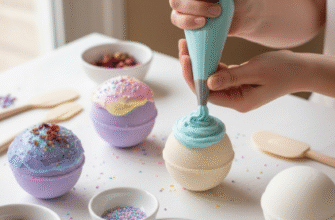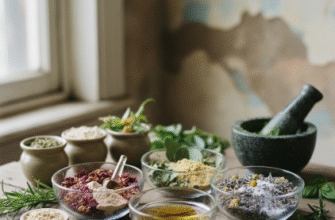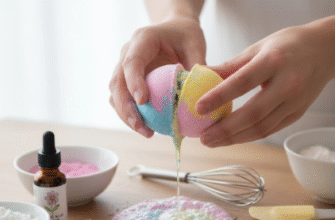Feeling that midday slump creep in? Or perhaps the warmth of the day is leaving your skin feeling a bit stressed and overheated? There are moments when all you crave is a simple, cooling splash to reawaken your senses and give your face a much-needed drink. Instead of reaching for complex, store-bought sprays, why not whip up your own little bottle of revitalizing magic right in your kitchen? Creating a refreshing face mist is surprisingly simple, especially when you harness the natural goodness of ingredients like crisp cucumber and invigorating mint.
This DIY Cucumber & Mint Face Mist is your secret weapon against tired, thirsty skin. It’s light, instantly cooling, and feels like a gentle spa treatment in a spritz. Forget heavy creams or complicated routines; sometimes, the simplest solutions are the most effective. This mist delivers hydration and a burst of freshness whenever you need it most, making it a perfect addition to your desk, gym bag, or bedside table.
Why Cucumber and Mint? Nature’s Refreshing Duo
Let’s talk about why these two green goodies are perfect partners for a facial mist. They aren’t just for salads or mojitos; they offer some lovely, gentle benefits for your skin.
Cucumber: The Hydration Hero
Think about biting into a cool slice of cucumber – it’s mostly water, right? That high water content translates beautifully into skincare. Cucumber is incredibly hydrating, helping to replenish moisture levels in your skin without feeling heavy or greasy. It’s naturally cooling and has a reputation for being soothing, which is why it’s often used to calm the skin, especially after sun exposure or when feeling generally irritated. It just feels inherently gentle and refreshing, making it ideal for all skin types, even sensitive ones needing a calm touch.
Mint: The Cool Awakening
Mint is all about that invigorating tingle and fresh scent. The menthol naturally present in mint leaves provides an immediate cooling sensation on the skin, which feels absolutely divine when you’re feeling hot, flushed, or simply exhausted. That coolness can help wake up tired skin and give you a quick sensory boost. While it’s known for this bracing effect, it’s best used in moderation in skincare, which is why combining it with gentle cucumber creates a balanced and pleasant experience. The fresh, clean aroma is an added bonus, helping to lift your spirits with every spritz.
Together, cucumber and mint create a mist that hydrates, cools, and provides an instant pick-me-up. It’s a straightforward combination that focuses on delivering refreshment without fuss.
Whipping Up Your Own Mist: It’s Easier Than You Think!
Ready to create your personal bottle of cool? The process is simple and requires minimal equipment. Here’s how to make your own Cucumber & Mint Face Mist:
What You’ll Need: Ingredients
- 1/2 large cucumber: Choose a fresh, firm cucumber. No need to peel it if it’s organic or well-washed, as the peel contains nutrients too. Roughly chop it.
- A generous handful of fresh mint leaves: About 10-15 leaves should do. Wash them thoroughly. Spearmint or peppermint work well.
- 1/2 cup distilled water or filtered water: Using distilled water helps extend the shelf life slightly compared to tap water, which can contain minerals and impurities. Filtered water is a good second choice.
- Optional: 1 teaspoon Aloe Vera Gel (pure): For extra soothing and hydration. Ensure it’s pure aloe vera without added colours or fragrances.
- Optional: A few drops of Witch Hazel (alcohol-free): Can add a slight toning effect, but ensure it’s the alcohol-free variety to avoid drying out the skin.
Equipment
- Blender
- Fine-mesh sieve or cheesecloth
- Bowl
- Small funnel (optional, but helpful)
- Clean, empty spray bottle (around 2-4 oz or 60-120 ml is ideal). Glass is preferable, but a clean plastic one works too. Ensure it’s sterilized (you can boil it or wash thoroughly with hot, soapy water and rinse well).
Step-by-Step Instructions
1. Blend the Stars: Place the chopped cucumber and fresh mint leaves into your blender. Add the 1/2 cup of distilled or filtered water. Blend on high speed for about 30-60 seconds, or until the mixture is smooth and liquidy. It should look like a vibrant green juice.
2. Strain for Clarity: Position your fine-mesh sieve or line a bowl with cheesecloth. Pour the blended cucumber and mint mixture through the sieve or cheesecloth. Press down gently on the solids with the back of a spoon (or squeeze the cheesecloth) to extract as much liquid as possible. You want a clear, pulp-free liquid. Discard the solids (they make great compost!).
3. Optional Add-Ins: If you’re using aloe vera gel or witch hazel, stir them into the strained liquid now. Mix gently until well combined.
4. Bottle It Up: Using a small funnel if you have one, carefully pour the finished liquid into your clean, sterilized spray bottle. Screw the spray top on tightly.
5. Chill Out: For the best experience and to help preserve it, store your freshly made face mist in the refrigerator. The cold temperature enhances the cooling effect and keeps the natural ingredients fresher for longer.
Handle With Care! Because this is a natural, preservative-free DIY recipe, it has a very short shelf life. Always store your mist in the refrigerator. Aim to use it up within one week for optimal freshness and safety. If you notice any change in smell, colour, or clarity, discard it immediately and make a fresh batch.
How and When to Use Your Cooling Creation
The beauty of this mist lies in its versatility. There’s no wrong way to enjoy its refreshing benefits! Here are a few ideas:
- Morning Wake-Up Call: Start your day with a spritz after cleansing to hydrate and awaken your skin before applying moisturizer or makeup.
- Midday Refresher: Keep it on your desk or in your bag for an instant pick-me-up when you hit that afternoon slump or feel overheated. A quick mist can revive both your skin and your focus.
- Post-Workout Cool Down: After exercising, a few sprays can feel incredibly soothing and help cool down flushed skin.
- After Sun Soother: While not a treatment for sunburn, the cooling cucumber and hydration can feel very comforting on skin that’s been exposed to the sun. Store it in the fridge for an extra cooling effect.
- Setting Spray Alternative (Light): While not a dedicated setting spray, a light mist *over* makeup (from a distance) can help meld powders and give a slightly dewier finish. Test this carefully to ensure it doesn’t disturb your makeup.
- Before Bed Treat: Use it after your evening cleanse for a final touch of light hydration and a calming scent before sleep.
How to Apply: Hold the bottle about 6-8 inches away from your face, close your eyes, and lightly mist 2-3 times. Let it air dry or gently pat it in. There’s no need to rinse it off. Enjoy that instant wave of cool!
Storage and Shelf Life: Keeping it Fresh
This is crucial for any DIY product made with fresh ingredients. As mentioned in the warning block, this mist contains no preservatives. Bacteria love water-based concoctions, especially those with fresh plant matter.
Always store your DIY Cucumber & Mint Face Mist in the refrigerator. This slows down potential bacterial growth and keeps the ingredients fresh.
Use it within one week. Seriously. Don’t try to stretch it longer. It’s easy and quick to make a fresh batch, so it’s better to be safe. If it looks cloudy, smells off, or changes colour before the week is up, toss it out.
Making smaller batches more frequently is often better than making a large bottle you can’t finish in time. The 2-4 oz bottle size is usually perfect for a week’s use.
Simple Variations and Ideas
Want to customize your mist slightly? Here are a few simple tweaks:
- Green Tea Boost: Replace the distilled water with cooled, strongly brewed green tea. Green tea is known for its antioxidant properties. Just brew a cup, let it cool completely, then use 1/2 cup in place of the water in the recipe. Remember, this still needs refrigeration and has a one-week shelf life.
- Rosewater Touch: Add a tablespoon of pure rosewater to the final strained liquid for a lovely floral scent and its reputed calming properties.
- Lemon Zest (Use Caution): Adding a tiny amount of lemon juice (like 1/4 teaspoon) can offer a brightening feel, but be very careful. Lemon juice can make your skin more sensitive to the sun (photosensitive) and can be irritating for some. Patch test diligently and avoid sun exposure right after use if you add lemon. Generally, sticking to cucumber and mint is gentler.
Creating your own skincare can be a fun and rewarding process. This Cucumber & Mint Face Mist is a fantastic starting point – it’s simple, effective, and feels wonderfully luxurious despite its humble ingredients. It’s a small act of self-care that delivers instant refreshment, reminding you to take a moment to cool down and recharge whenever you need it. So go ahead, blend, strain, spritz, and enjoy your homemade burst of freshness!








